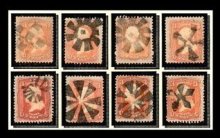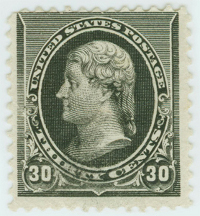1932 - Washington Bicentennial Postage Stamps
by Kenneth Perry
18th of October 2010
1932
GEORGE WASHINGTON BICENTENNIAL
POSTAGE STAMPS
In cooperation with the National Celebration of the Two Hundredth Anniversary of the birth of George Washington, the United States Post Office Department authorized a special series of 12 postage stamps in denominations of ½ cent to 10 cents, inclusive, to be kept on sale throughout the anniversary period in lieu of the regular series of stamps.
The year 1932 marked the 200th anniversary of the birth of George Washington. A wide variety of events celebrating this bicentennial was planned throughout the nation and the Post Office planned a series of stamps to commemorate the anniversary as well. Early ideas had the series being a set of bi-colored large frame pictorial stamps including among other things, Washington's home at Mt. Vernon, the crossing of the Delaware, Washington at Valley Forge, George and Martha Washington, Washington on horseback, the U.S. Capitol, Washington's tomb, the Wakefield, Virginia homestead where Washington was born, the inauguration of Washington, Washington resigning his commission and the Washington monument. This may have led to a very attractive set of commemorative stamps had the concept of using various portraits of Washington not won out.
In another early proposal, the Postmaster suggested an issue of as many as eighteen stamps through the $5 value, most likely to replace the Series of 1922 designs. Congress even got into the act with a bill proposing that all postage stamps issued in the United States and its possessions for the entire year of 1932 would bear the portrait of Washington. The bill never passed.
Ultimately the stamps were issued in single colors in the same size as the regular issues, most certainly as a cost-cutting measure, after all 1932 was in the heart of the Great Depression.
It was no accident that the two cent stamp bears the popular Gilbert Stuart portrait, the same portrait, although reversed, as the one that appears on the one dollar bill. The two cent was the most common stamp, being the rate for the first class letter.

2¢ - The likeness of Washington by Gilbert Stuart from a painting made at Germantown, Pa., in 1796, known as the Atheneum portrait, the original of which is now in the Boston Museum of Fine Arts. (4,222,198,300 issued)

* see the ten cent issue


½¢ - The likeness of Washington taken from a miniature painted by Charles Wilson Peale in 1777, the original of which is in the Metropolitan Museum of Art. (87,969,700 issued)
1½¢ - The likeness of Washington modeled from a painting known as the Virginia Colonel made at Mount Vernon in 1772 by Charles Wilson Peale, the original of which is now in Washington and Lee University. (304,926,800 issued)
3¢ - The likeness of Washington in the uniform of a general with cocked hat reproduced from a portrait by Charles Wilson Peale painted at Valley Forge in 1777. The original portrait is now in the State Normal School at West Chester, Pa. (456,198,500 issued)
5¢ - The likeness of Washington from a painting by Charles Wilson Peale made in 1795, and now in the possession of the New York Historical Society. (170,565,100 issued)


1¢ - Reproduction of the profile bust of Washington by Jean Antoine Houdon made in 1785 and now in Mount Vernon. 265,555,100 issued)


4¢ - The likeness of Washington taken from a painting by Charles Willson Peale. The painting was donated to the National Portrait Gallery by its former owner, Mr. William Patten, Rhinebeck, N.Y. (151,201,300 issued)


6¢ - Representing Washington in the uniform of a general reproduced from a painting by John Trumbull in 1792, now in Yale University. (111,739,400 issued)
7¢ - The portrait painted by John Trumbull in 1780, the original of which is now in the Metropolitan Museum of Art. (83,257,400 issued)


8¢ - The profile bust portrait of Washington facing to the left, reproduced from a crayon drawing made from life by Charles Balthazar Julien Févret de Saint-Mémin at Philadelphia in 1798. (96,506,100 issued)
9¢ - The likeness of Washington modeled from a pastel portrait in the possession of the Masonic lodge of Alexandria, Va., for whom it was drawn from life by W. Williams in 1794. (75,709,200 issued)
*10¢ - The portrait of Washington taken from a painting by Gilbert Stuart in 1795, now in the possession of the Metropolitan Museum of Art in New York City. (147,216,000 issued)

HISTORY OF ...
George Washington ( February 22, 1732 – December 14, 1799 ) served as the first President of the United States of America ( 1789–1797), and led the Continental Army to victory over the Kingdom of Great Britain in the American Revolutionary War (1775–1783 ).
The Continental Congress appointed Washington commander-in-chief of the American revolutionary forces in 1775. The following year, he forced the British out of Boston, lost New York City, and crossed the Delaware River in New Jersey, defeating the surprised enemy units later that year. As a result of his strategy, Revolutionary forces captured the two main British combat armies at Saratoga and Yorktown. Negotiating with Congress, the colonial states, and French allies, he held together a tenuous army and a fragile nation amid the threats of disintegration and failure. Following the end of the war in 1783, Washington retired to his plantation at Mount Vernon, prompting an incredulous King George III to state, "If he does that, he will be the greatest man in the world."
Dissatisfied with the Articles of Confederation, he presided over the Philadelphia Convention that drafted the United States Constitution in 1787. Washington became President of the United States in 1789 and established many of the customs and usages of the new government's executive department. He sought to create a great nation capable of surviving in a world torn asunder by war between Britain and France. His unilateral Proclamation of Neutrality of 1793 provided a basis for avoiding any involvement in foreign conflicts. He supported plans to build a strong central government by funding the national debt, implementing an effective tax system, and creating a national bank. Washington avoided the temptation of war and began a decade of peace with Britain via the Jay Treaty in 1795; he used his prestige to get it ratified over intense opposition from the Jeffersonians. Although never officially joining the Federalist Party, he supported its programs and was its inspirational leader. Washington's farewell address was a primer on republican virtue and a stern warning against partisanship, sectionalism, and involvement in foreign wars.
Washington is seen as a symbol of the United States and republicanism in practice. His devotion to civic virtue made him an exemplary figure among early American politicians. Washington died in 1799, and in his funeral oration, Henry Lee said that of all Americans, he was "first in war, first in peace, and first in the hearts of his countrymen." Washington has been consistently ranked by scholars as one of the greatest U.S. Presidents.
This is a re-write of a previous exhibit entry in Stamporama ... Perry


